Without accurate timekeeping, space navigation would be impossible. As NASA goes forward to the Moon with the Artemis missions, precise measurements of time are key to mission success.
To calculate where a spacecraft is in the solar system, NASA must measure the time it takes for electromagnetic waves traveling at the speed of light to flow between the spacecraft and known locations, like an antenna on Earth.
Download infographic as PDF (1 MB)
By multiplying that time by the speed of light, NASA knows the distance between the spacecraft and the ground station — distance equals velocity multiplied by time. Over a period of time, NASA can collect enough of these time measurements converted to distances to accurately compute where the spacecraft is and where it is going.
Without incredible timekeeping precision, these calculations could be wildly inaccurate.
Fortunately, atomic clocks provide the accuracy NASA needs. A modern mechanical watch that one might wear on their wrist can be off by about three seconds per day. The array of atomic clocks used by the U.S. Naval Observatory, the Master Clock, only deviates by 100 picoseconds (0.000 000 000 1 seconds) per day.
Atomic clocks observe the ultra-stable oscillations of the atoms trapped within them. At the Naval Observatory, they rely on dozens of cesium and hydrogen maser clocks. Global Navigation Satellite Systems (GNSS), such as GPS and other similar systems, use multiple onboard atomic clocks for timekeeping, but they’re too heavy and bulky to put on exploration spacecraft where size, weight and power consumption are at a premium. So, in order to calculate a precise location, today’s exploration spacecraft must receive and return a signal from a location with an atomic clock, then wait for orders.
This process can take hours, and doesn’t offer the level of autonomy and responsiveness NASA needs for future deep space exploration. As NASA goes forward to the Moon and ventures on to the Red Planet, navigation engineers must develop revolutionary ways to keep time and navigate the stars.
Deep Space Atomic Clock
For 20 years, NASA’s Jet Propulsion Laboratory in Pasadena, California, has been perfecting an atomic clock small and lightweight enough for exploration missions. While atomic clocks at ground stations that are part of NASA’s Deep Space Network are about the size of a refrigerator, the Deep Space Atomic Clock is about the size of a four-slice toaster, and could be further miniaturized for future missions.
The Deep Space Atomic Clock can be so small because it uses new, mercury-ion trap technology. Engineers expect that the clock will maintain a deviation less than two nanoseconds (0.000 000 002 seconds) per day. That type of accuracy could enable a spacecraft or astronauts to make navigation decisions on their own, rather than waiting for communications from Earth.
The clock will fly aboard the General Atomics Electromagnetic Systems Orbital Test Bed satellite, launching in June 2019. After launch, it will perform a year-long demonstration, confirming its performance against GPS satellite atomic clocks. Once the technology has been proven, small, mercury-ion trap clocks could be integrated into future deep space missions.
GNSS Space Service Volume and Beyond
Spacecraft near Earth don’t usually require a timekeeping device like the Deep Space Atomic Clock. In low-Earth orbit, below an altitude of approximately 1,860 miles (about the distance from Maine to Puerto Rico), a spacecraft can rely on one-way signals from any one GNSS constellation to instantaneously determine position and time. These spacecraft could simply use GPS to provide them with all the information they need to navigate, just as it does for users on the ground.
Beyond this altitude, navigation becomes more challenging. It becomes necessary to combine signals from multiple GNSS constellations. This more challenging region stretches up to geosynchronous orbit (some 22,000 miles) and is known as the GNSS Space Service Volume.
But, NASA engineers want to reach even higher. In fact, NASA simulations show GNSS signals could even be used for reliable navigation in lunar orbit, far outside the space service volume, over 200,000 miles from Earth. Engineers are considering using GNSS signals in the navigation architecture for the Gateway, an outpost in orbit around the Moon that will enable sustained lunar surface exploration.
Download infographic as PDF (1 MB)
X-Ray Timing and Navigation
X-ray navigation might sound like it belongs in a science fiction novel, but it’s a real technology that NASA has already demonstrated on the International Space Station. X-ray navigation doesn’t rely on tiny atoms for timing information. Instead, it uses the ultra-regular oscillations of distant pulsars, a type of neutron star, for timing and location data.
Engineers can calculate a spacecraft’s position in space by comparing a pulsar’s predicted pulse time of arrival with the observed pulse time of arrival, combined with specialized onboard navigation software. The unique pulses from a subset of these stars can be used for time since they can be accurately predicted down to the microsecond for years into the future. Since astronomers know where some pulsars are located on the celestial sphere, they can provide both time and location for spacecraft outside the near-Earth region, enabling a galactic positioning system.
X-ray navigation in space could revolutionize deep space exploration, giving future missions the capabilities they need to maintain time and navigate with minimal oversight. Using X-ray navigation, NASA could even launch autonomous, robotic spacecraft to Mars, the far reaches of the solar system and beyond.
Download infographic as PDF (500 KB)
The Space Technology Mission Directorate rapidly develops, demonstrates and infuses revolutionary, high-payoff technologies through transparent, collaborative partnerships, expanding the boundaries of the aerospace enterprise. Their contributions to the development of innovative technologies like the Deep Space Atomic Clock and X-ray pulsar navigation promise to enable the next generation of exploration, including going forward to the Moon in 2024.
NASA’s Space Communications and Navigation (SCaN) program office oversees the agency’s work in navigation policy related to GNSS. NASA, consulting the United Nations International Committee on GNSS (ICG), collaborates with other U.S. agencies and the six international GNSS providers to define GNSS requirements and develop additional capabilities. Their work will ensure that NASA missions like the Gateway, a lunar-orbiting space station, can take advantage of GNSS signals for navigation.

































